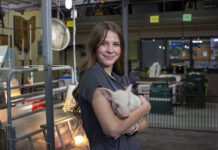COLUMBUS — No-till is recognized globally as an ideal means of conserving soil and water while also storing soil carbon, but the agricultural practice may not be applicable under all environmental conditions.
Ohio State University soil scientists measured carbon levels in no-till fields throughout seven states and found soil texture, moisture, temperature and terrain parameters affected the amount of carbon stored on the soil surface.
“The message here is that no-till is not applicable everywhere as a means of practicing carbon sequestration. There are situations where other carbon sequestration methods would be more effective,” said Rattan Lal, a soil scientist with Ohio State’s Ohio Agricultural Research and Development Center.
Benefits
No-till, the agricultural practice of leaving residue on the soil surface rather than plowing it under, has a myriad of ancillary benefits, including reduction in labor, reduction in machinery wear, decreased fossil fuel consumption, reduced soil erosion, improved soil productivity, increased wildlife habitats and a better method of maintaining and conserving soil water.
No-till is considered a successful carbon sequestration practice when carbon input (storage) exceeds carbon output (loss).
Carbon input includes crop residues, winter cover crops, complex farming systems and use of compost and manure.
The output includes losses of carbon by decomposition, erosion and leaching.
Studied no-till fields
Lal and his colleagues studied no-till fields in Ohio, Michigan, Indiana, Pennsylvania, Kentucky, West Virginia and Maryland and identified situations where the practice was the most effective in storing carbon and where it was not.
“Basically, those soils that are well-drained, are silt/silt-loam in texture, warm quickly and have some sloping characteristics prone to erosion are excellent candidates for no-till,” said Lal, director of Ohio Agricultural Research and Development Center’s Carbon Management and Sequestration Center.
“Clay soils or other heavy soils that drain poorly are prone to compaction and are in areas where the ground stays cooler may not always increase carbon storage through no-till.”
Ohio
In Ohio, for example, the researchers found no-till would store carbon on about 40 percent of the state’s cropland.
In actuality, no-till is practiced on 35 percent of Ohio’s field crops, said Lal.
“Globally, no-till is practiced on only 6 percent of the total cropland and mostly practiced in the U.S., Canada, Brazil, Australia, Argentina and Chile,” said Lal.
“There’s a reason for that — because it can be worked into practices in which carbon input exceeds carbon output.”
Other methods
In situations where no-till may not be ideal, there are plenty of other carbon sequestration methods available, including mulching, cover crops, complex crop rotations, mixed farming systems, agroforestry and biochar (a charcoal-like biomass material).
The study also compared carbon levels between no-till and conventional tillage fields and found, in some cases, carbon storage was greater in conventional tillage fields.
Soil depth is key
But the key, said Lal, is soil depth. “If you compare carbon storage between no-till and plowed fields with the plow depth, or the first 8 inches of the soil, carbon storage is generally much greater in no-till fields than in plowed fields,” said Lal.
“But if you go deeper, say 12 inches and deeper, one may find more carbon stored in plowed fields than in no-till.”
The message, said Lal, is farmers cannot measure soil carbon based just on surface depth.
“You have to go deeper,” said Lal. “We recommend going to as much as 1 meter (3.25 feet) below the soil surface.”
Lal said the study is not a criticism of no-till and its benefits, but simply a way of determining where the practice best fits and where other carbon sequestration methods may work better.
“In situations where no-till is ideal, it’s a sustainable soil management practice that simply can’t be ignored,” said Lal. “It saves time, money and wear on machinery and its profit margin is much higher than plowing.”
Lal said the results of the study are the beginnings of developing a soil ratings guide for applying different conservation tillage systems at regional and national scales.










Why is there no mention of Biomass or microbes? Their is a great deal of carbon sequestered in their numbers in a healthy soil. In addition they prevent leaching and improve structure even in clay soils.